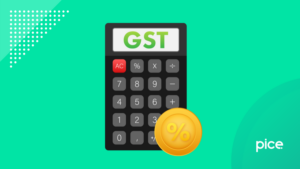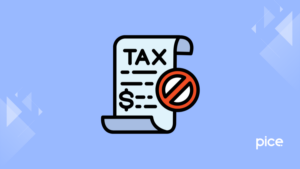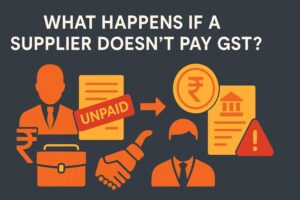Top GST Software in India
- 18 Aug 24
- 17 mins

Top GST Software in India
- What is GST Software?
- Complete GST Filing Software
- How GST Billing Software will Help Your Taxation?
- Who needs GST Filing Software?
- What is meant by cloud-based or on-premise GST software?
- Choose A Good GST Software
- Benefits of of Using Pice Business Payment App
- Top Factors To Consider While Selecting A GST Software
Key Takeaway
- GST software automates and streamlines the entire GST compliance process, from tax calculations and invoice generation to returns filing and reconciliation, minimizing manual errors and ensuring timely compliance.
- Businesses can choose between cloud-based or on-premise deployment models for GST software, depending on their specific requirements for remote access, scalability, data security, and budgetary considerations.
- When selecting a GST software, businesses should evaluate factors such as user-friendliness, integration capabilities, compliance with regulations, reporting and analytics features, scalability, and vendor support and training.
- GST software offers various integration options, including connectors, templates, APIs, and SFTP, allowing seamless data exchange with existing systems like accounting software, ERP, and e-commerce platforms.
- Implementing a comprehensive GST software solution can provide businesses with accurate tax calculations, compliant invoicing, input tax credit management, reconciliation, audit trails, and valuable insights through reporting and analytics.
What is GST Software?
GST (Goods and Services Tax) software is a type of accounting software designed specifically for companies to manage their GST filing process and compliance requirements under the GST regime in India. It helps businesses maintain proper records of their purchases, sales, input tax credit, and tax liability calculations as per GST rules.
GST software automates various GST-related processes, including:
- Tax Calculations: It calculates the correct GST rates for different products and services, ensuring accurate tax computation on transactions.
- Invoice Generation: GST software generates GST-compliant invoices, including all the mandatory fields required under the GST law, such as GSTIN, HSN/SAC codes, and tax breakdowns.
- Returns Filing: It facilitates the preparation and filing of various GST returns, such as GSTR-1 (Outward Supplies), GSTR-3B (Monthly Return), and GSTR-9 (Annual Return), by consolidating the necessary data.
- Input Tax Credit (ITC) Management: The software tracks and manages the input tax credit claimed on purchases, ensuring compliance with the ITC rules and regulations.
- Reconciliation Process: GST software reconciles the data from purchase and sales records with the figures reported in GST returns, identifying and resolving any discrepancies.
- E-way Bill Generation: For interstate movement of goods, GST software can generate e-way bills, which are mandatory for transportation.
- Reporting and Analytics: Many GST software solutions offer reporting and analytics features, providing valuable insights into tax liabilities, ITC utilization, and overall GST compliance status.
By using GST software, businesses can streamline their GST compliance processes, reduce manual errors, and ensure timely filing of returns, thereby minimizing the risk of penalties and interest charges.
Complete GST Filing Software
Connectors & Templates

A comprehensive GST software solution offers pre-built connectors and templates to integrate with your existing accounting software, ERP systems, e-commerce platforms, and other business applications. This seamless integration ensures data flow across systems without manual intervention.
The connectors enable the GST software to directly fetch and push data to and from other applications, such as accounting software like Tally or ERP systems like SAP, Oracle, or Microsoft Dynamics. This eliminates the need for manual data entry and reduces the risk of errors.
Templates, on the other hand, provide standardized formats for various GST-related documents, including invoices, credit/debit notes, e-way bills, and returns. These pre-designed templates ensure compliance with the GST laws and regulations, making it easier for businesses to generate accurate and consistent documentation.
API-based
Many GST software providers offer API (Application Programming Interface) integration, allowing you to connect the GST application with your in-house or third-party applications for real-time data exchange and automation.
APIs act as a bridge between different software systems, enabling them to communicate and share data seamlessly. Through API integration, businesses can automate processes such as invoice generation, tax calculation, and data synchronization, improving efficiency and reducing manual efforts.

API-based integration also allows for customization and scalability, as developers can build custom integrations or extensions tailored to the specific needs of the business.
SFTP-based
Secure File Transfer Protocol (SFTP) is another integration method used by GST software vendors. It allows businesses to upload large volumes of data securely from their systems to the GST application for processing.
SFTP is particularly useful for businesses that need to transfer bulk data, such as purchase invoices, sales records, or e-way bill information, to the GST software. It provides a secure and reliable way to transfer sensitive financial data, ensuring data integrity and confidentiality.
SFTP integration can be automated, enabling businesses to schedule regular data transfers without manual intervention, saving time and reducing the risk of errors associated with manual data entry.
By offering these integration options (connectors, templates, APIs, and SFTP), GST software solutions provide businesses with flexibility and scalability, allowing them to seamlessly integrate with their existing systems and streamline their GST compliance processes.
How GST Billing Software will Help Your Taxation?

Implementing a GST billing and invoicing software can significantly streamline your taxation processes. It automates GST calculations, generates GST-compliant invoices and returns, manages input tax credit, reconciles data, and ensures timely tax compliance filings. This minimizes manual errors, saves time, and reduces the risk of penalties. Here's how GST billing software can help with your taxation:
- Accurate Tax Calculations: The software automatically calculates the correct GST rates for different products and services, ensuring accurate tax computation on every transaction.
- Compliant Invoicing: GST billing software generates invoices that comply with GST regulations, including all the mandatory fields, such as GSTIN, HSN/SAC codes, and tax breakdowns.
- Input Tax Credit (ITC) Management: It tracks and manages the input tax credit claimed on purchases, ensuring compliance with ITC rules and regulations.
- Returns Filing: The software consolidates the necessary data and facilitates the preparation and filing of various GST returns, such as GSTR-1, GSTR-3B, and GSTR-9.
- Reconciliation: It reconciles the data from purchase and sales records with the figures reported in GST returns, identifying and resolving any discrepancies.
- Audit Trail: GST billing software maintains a comprehensive audit trail of all transactions, making it easier to provide supporting documentation during tax audits.
- Reporting and Analytics: It provides valuable insights into tax liabilities, ITC utilization, and overall GST compliance status through customized reports and analytics.
- Payment Reminders: The software can send automated payment reminders to customers for outstanding invoices, ensuring timely receipt of payments and better cash flow management.
By automating these processes, GST billing software minimizes the risk of errors, ensures compliance, and saves time and resources that would otherwise be spent on manual calculations and data entry.
💡If you want to pay your GST with Credit Card, then download Pice Business Payment App. Pice is the one stop app for all paying all your business expenses.
Who needs GST Filing Software?
Any business registered under the GST regime in India, irrespective of its size or industry, can benefit from using a GST software solution. This includes:
- Manufacturers: Companies involved in manufacturing goods need GST accounting software to manage their input tax credit, generate compliant invoices, and file returns accurately.
- Traders: Traders and wholesalers dealing with the purchase and sale of goods can use GST software to calculate taxes, generate invoices, and maintain records for GST compliance.
- Service Providers: Business activities such as consultancies, IT firms, and professional services, need GST software to manage their service tax calculations, invoicing process, and returns filing.
- E-commerce Sellers: Online sellers and e-commerce businesses require GST software to handle their tax calculations, invoice generation, and compliance requirements across multiple states.
- Businesses with Multi-state Operations: Companies with operations spanning multiple states or union territories in India find GST software essential for managing their tax liabilities across different jurisdictions.
In essence, any business registered under the GST regime, regardless of its size or industry, can benefit from implementing a GST software solution to streamline their taxation processes, ensure compliance, and minimize the risk of penalties.
What is meant by cloud-based or on-premise GST software?
GST software can be deployed in two primary modes: cloud-based or on-premise. The key differences between these two deployment models are as follows:
- Cloud-based GST Software: Cloud-based GST software, also known as Software-as-a-Service (SaaS), is hosted on the vendor's cloud servers, and businesses can access it through the internet using a web browser or a dedicated application. With this model, the software and data are stored and maintained remotely by the vendor.
Key features of cloud-based GST software:
- Remote Access: Users can access the software from anywhere with an internet connection, enabling remote work and collaboration.
- Automatic Updates: Software updates and patches are automatically applied by the vendor, ensuring that users always have access to the latest version and features.
- Scalability: Cloud-based solutions can easily scale up or down based on the business's changing needs, without the need for additional hardware or infrastructure.
- Pay-as-you-go: Cloud-based GST software typically follows a subscription-based pricing model, where businesses pay a monthly or annual fee based on their usage.
- On-premise GST Software: On-premise GST software is installed and runs on the company's own servers or local machines within their premises. The software and data are hosted and managed by the business itself, providing greater control and security.
Key features of on-premise GST software:
- Control and Customization: Businesses have complete control over the software, allowing for customizations and integrations tailored to their specific requirements.
- Data Security: With on-premise deployment, sensitive data remains within the company's internal network, providing an additional layer of security and compliance with data privacy regulations.
- Upfront Costs: On-premise solutions typically require a larger upfront investment for purchasing the software licenses, hardware infrastructure, and implementation services.
- Maintenance and Updates: The business is responsible for maintaining the software, applying updates, and ensuring backups and disaster recovery measures.
The choice between cloud-based or on-premise GST software depends on various factors, such as the size of the business, IT infrastructure, data security requirements, scalability needs, and budget considerations. Cloud-based solutions are often preferred by small and medium-sized businesses due to their lower upfront costs and ease of deployment, while larger enterprises with stringent security requirements may opt for on-premise solutions.
Ultimately, businesses should carefully evaluate their specific needs and considerations to determine the most suitable deployment model for their GST software.
Choose A Good GST Software
in grey: GST (Goods and Services Tax) billing and accounting software is a cornerstone for businesses managing their tax obligations efficiently. Pice, the top GST billing software, comes packed with features designed to simplify your financial processes of tax compliance, billing, and financial management.
How To Find The Best GST Software for Professional?

Selecting the right GST software is crucial for efficient tax management and compliance. Choosing the wrong software can lead to errors, potential penalties, and lost productivity. Here are some steps to help you find the best GST software for your business:
- Assess Your Business Requirements: Start by evaluating your business's specific needs, such as the number of transactions, integration requirements with existing systems (e.g., accounting software, ERP), the level of automation desired, and the number of users who will access the software.
- Research and Compare Options: Create a list of popular GST software solutions available in the market. Look for software vendors with a good reputation, positive customer reviews, and a proven track record in the industry.
- Check for Compliance and Updates: Ensure that the GST software you're considering is fully compliant with the latest GST regulations and can handle future updates or changes in tax laws seamlessly.
- Evaluate Features and Functionality: Analyze the features and functionality offered by each software solution. Look for features like automated tax calculations, invoice generation, returns filing, input tax credit management, reconciliation, reporting, and analytics.
- Consider Integration Capabilities: If you plan to integrate the GST software with your existing systems (e.g., accounting software, ERP, e-commerce platforms), evaluate the integration options offered by the vendor, such as APIs, connectors, or SFTP capabilities.
- Assess User-Friendliness: A friendly user interface can significantly improve productivity and reduce the learning curve for your team. Look for software with an intuitive user interface.
- Check for Support and Training: Evaluate the level of support and training provided by the software vendor. Reliable customer support, documentation, and training resources can be invaluable, especially during the initial implementation phase.
- Consider Scalability and Pricing: As your business grows, you'll want a software solution that can scale with your needs. Evaluate the pricing plans and total cost of ownership (TCO), including initial costs, recurring fees, and any additional charges for customization or support.
- Request Demos and Trials: Most software vendors offer demos
or trial periods. Take advantage of these opportunities to test the software's functionality, usability, and compatibility with your existing systems before making a decision. - Seek Recommendations: Reach out to industry experts, professional associations, or peers in your network to gather insights and recommendations on the best GST software solutions for businesses similar to yours.
Benefits of of Using Pice Business Payment App
Pice Payment App offers a comprehensive suite of features that streamline the accounting and taxation processes for businesses. It’s designed to meet the needs of modern enterprises, from small startups to large corporations, especially those operating in India where GST compliance is crucial.
Below, we discuss the key benefits of using Pice, highlighting its essential features and how they contribute to business efficiency and compliance.
- Seamless Integration with Banking Systems: Pice supports seamless integration with bank accounts, facilitating automatic reconciliation of financial transactions. This integration helps in maintaining accurate records, enhances payment methods, and streamlines the process of financial reporting and tax filing.
- Advanced Reporting Capabilities: The software comes equipped with tools to generate accurate reports, including sales reports, GST return filings, and analysis reports. These smart analytics reports are essential for maintaining proper account management and help businesses monitor their financial health, optimize their tax liabilities, and make informed decisions.
- Customizable Invoicing Solutions: Pice provides customizable invoicing solutions that enable businesses to create professional customer invoices, manage GST invoice details, and adjust invoice themes to match the business branding. This flexibility helps maintain a positive brand image and ensures compliance with GST invoicing standards.
- Mobile Accessibility: The availability of mobile application ensures that users can access their financial data and perform essential tasks from anywhere. This accessibility is particularly beneficial for businesses that require constant updates on their financial status and wish to manage operations on the go.
- Comprehensive GST Compliance: Pice is designed to handle all aspects of GST compliance, from basic usage to complex GST return filing software requirements. It supports service tax calculations, manages input tax credits effectively, and ensures that businesses stay compliant with all GST-related regulations.
- Payment of other business expenses using Credit Card: Users can make all their business payments such as vendors, rent, electricity, GST and others with their Credit Card through Pice. The user also earns cashback with every transaction made on the platform.
- Enhanced Data Security: With features like automatic backup and secure data handling, PICE GST Software ensures that all financial data remains safe from unauthorized access and data breaches. This security is crucial for maintaining trust and upholding a business’s reputation.
- Positive Impact on Business Performance: By automating and simplifying complex processes like GST filings, expense management, and financial reporting, Pice enables businesses to focus more on strategic activities rather than administrative tasks. This can lead to improved overall business performance and efficiency.
Top Factors To Consider While Selecting A GST Software
When it comes to selecting a GST software for your business, it's important to consider several key factors to ensure you choose a solution that meets your specific requirements and contributes to efficient GST compliance. Here are some of the top factors to consider:
- User-friendly interface: The GST software you choose should have an intuitive and user-friendly interface that simplifies data entry, navigation, and reporting processes. A well-designed interface can improve productivity and reduce the learning curve for your team, ensuring a smooth transition and adoption of the new software.
- Automation and Integration: Look for a GST software that offers a high degree of automation for tasks such as tax calculations, invoice generation, and returns filing. Additionally, evaluate its integration capabilities with your existing systems, such as accounting software, ERP solutions, and e-commerce platforms, to ensure seamless data flow and minimize manual intervention.
- Compliance and Updates: Ensure that the GST software you choose is fully compliant with the latest GST regulations and can handle future updates or changes in tax laws seamlessly. This will help you avoid potential penalties and ensure ongoing compliance.
- Reporting and Analytics: A comprehensive GST software should provide robust reporting and analytics capabilities, enabling you to generate detailed reports on tax liabilities, input tax credit utilization, and overall GST compliance status. This can help you make informed business decisions and identify areas for improvement.
- Scalability: As your business grows, your GST software should be able to scale alongside your increasing needs. Consider a solution that can handle a larger volume of transactions, support multiple locations or branches, and accommodate future expansion or diversification.
- Security and Data Protection: Data security should be a top priority when selecting a GST software. Evaluate the vendor's security measures, such as data encryption, access controls, and backup and recovery processes, to ensure the protection of your sensitive financial and business data.
- Support and Training: Reliable customer support and comprehensive training resources can be invaluable, especially during the initial implementation phase and when navigating complex GST regulations. Assess the vendor's support offerings, including documentation, online resources, and training programs.
- Pricing and Total Cost of Ownership (TCO): While the upfront cost of the software is important, it's crucial to consider the total cost of ownership (TCO), including implementation costs, recurring fees, and any additional charges for customization, support, or future upgrades. Evaluate the pricing plans and choose a solution that fits your budget while meeting your business requirements.
- Vendor Reputation and Experience: Research the vendor's reputation, experience, and track record in the GST software market. Consider factors such as customer reviews, industry recognition, and the vendor's financial stability and long-term commitment to the product.
- Mobile Accessibility: In today's mobile-driven world, it can be beneficial to have a GST software solution that offers mobile accessibility, allowing you and your team to access relevant data and perform essential tasks on-the-go, further enhancing productivity and convenience.
By carefully evaluating these factors and prioritizing your business's specific needs, you can increase the chances of finding a GST software solution that streamlines your taxation processes, ensures compliance, and contributes to the overall success of your business.
 By
By 

















